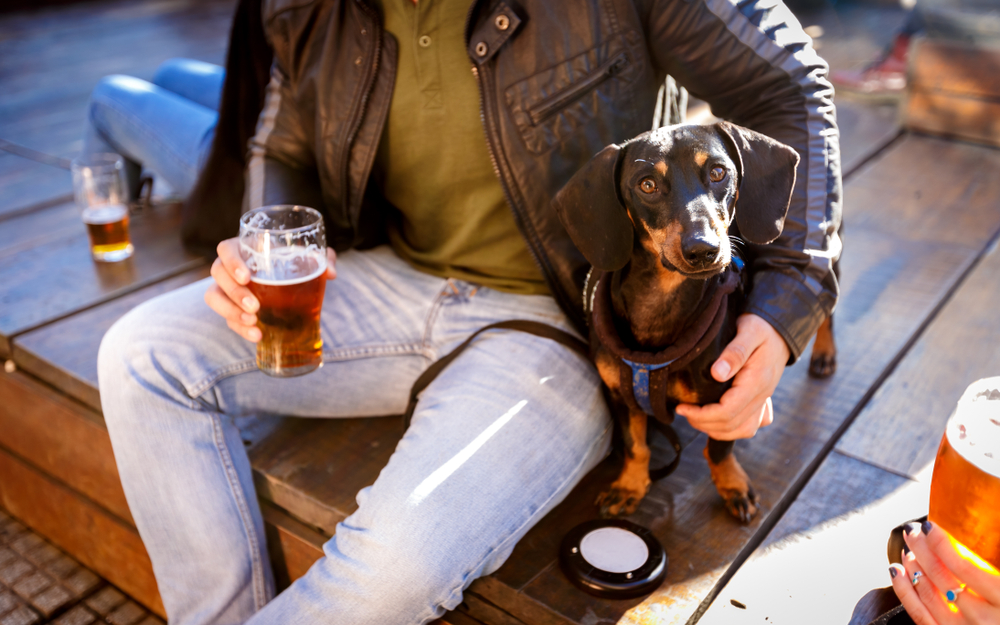Whether you’re Irish or not, St. Patrick’s Day celebrations are always a great “craic.” Nevertheless, if you’re planning on celebrating the Emerald Isle with your faithful pooch this coming March, there are a few important safety tips to keep in mind—especially if alcohol, shamrocks, and Irish soda bread are on the menu.
If you’re worried about your dog’s safety during the celebrations, we’re here to bring you the luck of the Irish with some top tips for keeping your dog safe, well, and happy on Saint Patrick’s Day.

The 6 St. Patrick’s Day Safety Tips for Dogs
1. Keep an Eye on Your Beer

If beer or any other kind of alcohol will be making an appearance during the event, be sure to keep it out of your dog’s reach. If a dog consumes alcohol, it can result in signs like depression, lethargy, lack of coordination, weakness, vomiting, and, in some cases, dogs can collapse.
Moreover, blood sugar, blood pressure, and body temperature levels can lower, and the breathing rate may slow down. Body type and weight play a factor in how much alcohol is needed to affect a dog, just like in humans. For example, a little bit of alcohol may be more dangerous for a very small dog (like a toy breed) than it would be for a larger dog.
Though dogs aren’t typically attracted to beer, it can get accidentally spilled, and your dog may not be able to contain their curiosity. For this reason, it’s a good idea to keep a close eye on your drink and ask others around you to do so, too. Please contact a pet poison hotline or your vet if you suspect that your dog has gotten their paws on an unattended beverage.
If you need to speak with a vet but can't get to one, head over to PangoVet. It's an online service where you can talk to a vet online and get the personalized advice you need for your pet — all at an affordable price!
2. Don’t Treat Your Dog to Irish Soda Bread
Irish soda bread is a treat commonly found at St. Patrick’s Day events. Though it might be tempting to give your dog a little nibble, resist the urge because Irish soda bread contains raisins, which are very toxic to dogs and just a couple can permanently damage their kidneys. If you’d like for your dog to join in the celebrations, stock up on some safe treats instead. You can even find recipes for homemade St. Patrick’s Day dog treats online.
3. Keep Shamrocks Away from Your Dog

Also known as “sorrel” or “oxalis,” shamrocks are popular St. Patrick’s Day offerings. Be sure to keep these out of your dog’s reach, though, as Shamrocks are toxic to dogs due to the presence of soluble oxalate.
Signs of soluble calcium oxalate poisoning include lack of appetite, vomiting, lethargy, drooling, diarrhea, tremors, blood in the urine, changes in urination and thirst, and weakness. The good news is that Shamrocks taste very bitter, which is often enough to stop dogs from having more than a nibble, but it’s still a good idea to be vigilant.
4. Avoid Taking Your Dog to Parades
If you’re planning to go to a parade or another crowded environment, it’s best to leave your dog at home for safety reasons if possible. Crowded and busy places can be really stressful for dogs as there are a lot of new sounds, smells, and noises, and often loud ones at that.
Moreover, there’s always the risk of you and your dog getting separated by a particularly rambunctious throng. If you do take your dog to a busy event, keep them on a secure leash and make sure they have an ID tag or GPS tracker, just in case.
5. Never Use Human Hair Dye
For those who want to give their dog a green mohawk or something like it for St. Patrick’s Day, be sure to never use human hair dye. It’s toxic and can seriously damage the skin and coat, resulting in pain and irritation. Chemical burns are another possibility, so steer clear.
There are some safe alternatives, including dog-friendly hair dyes and food coloring, which is non-toxic and comes from natural sources.
6. Be Mindful of Foods to Avoid

In addition to alcohol and Irish soda bread, keep an eye out for certain foods that are toxic to dogs. These include (but are not limited to):
- Onions
- Garlic
- Chives
- Grapes
- Raisins
- Salty/fatty foods
- Chocolate
- Macadamia nuts
- Pecans
- Walnuts
- Almonds
- Xylitol (artificial sweetener)
- Avocado
- Caffeine
- Corn on the cob
- Citrus
- Milk
- Dairy products

Can I Dress My Dog Up for St. Patrick’s Day?
Some people enjoy dressing up their dogs for celebrations. The PDSA recommends avoiding dressing up dogs because it looks funny or cute and advises sticking to clothes that benefit your dog in some way (i.e., hi-vis jackets, therapy vests, and winter jackets).
Wearing a costume can feel restrictive for dogs and, in some cases, can cause them to feel very stressed out because it’s not something dogs naturally do. The clothes may also feel itchy and uncomfortable, and make the dog feel hot. If you do decide to dress up your dog, weigh up whether it will be comfortable and safe for them—some clothes can get tangled around your dog’s neck and cause them to choke or get stuck on something.


Conclusion
Fortunately, there are several ways you can keep your dog safe and well while enjoying those jolly St. Patrick’s Day vibes. Most of them involve keeping certain treats, gifts, and beverages away from curious noses. With a few simple precautionary measures, there’s no reason why you and your dog won’t be grand. Enjoy!
See also:
Featured Image Credit: New Africa, Shutterstock



















